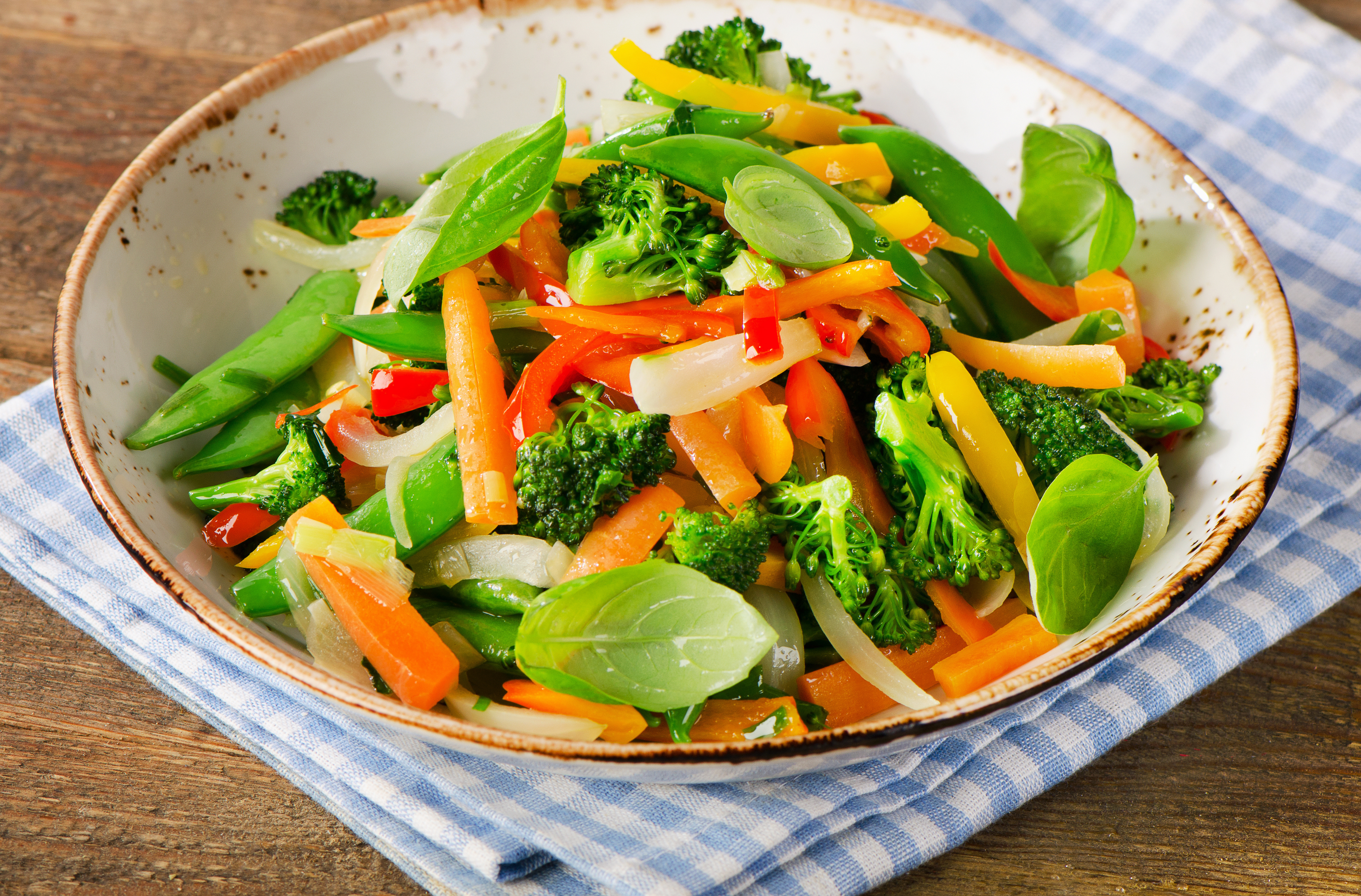
There are many different cooking methods and even more products that can be used to perform these methods. A popular product to use for cooking is oil. However, you must be careful when using these oils. If you use the wrong oil for a dish; you will not only ruin your meal but your health in the process. Oils are typically used for stir-frying, but you cannot use just any oil. You need to consider the different kinds of fat content and the smoke point of these oils before choosing one to stir-fry with. Stir-frying can be good or bad for you depending on which oil you choose. So, choose wisely. Here are a couple of factors you should consider when picking out oil for your stir-fry.
The Right Fat
There are good fats, and there are bad fats. Saturated fats and trans fats can raise your cholesterol and cause unhealthy weight gain. Trans fat, in particular, increase your low-density lipoprotein (bad cholesterol) and decrease your high-density lipoprotein (good cholesterol). Other factors may include adverse effects on heart health, the risk of cancer, and obesity. The American Heart Association suggests that you lower your trans-fat intake to less than 7 percent of your caloric intake.
Polyunsaturated and monounsaturated fats have a different effect. They are known to improve cholesterol levels. Monounsaturated fats, in particular, are crucial to pay attention to when stir-frying. Monounsaturated fat has high resistance to the oxidation and hydrogenation that occurs when cooking in high temperatures. These are the processes that turn many oils into trans fats. Monosaturated fats don’t have this problem because they are very heat resistant. If your oil is low in monounsaturated fat, then it is not a good idea to stir-fry with it.
Smoke Point
The smoke point is crucial when choosing an oil to stir-fry with. The smoke point is the temperature that the oil breaks down at. At that point, the oil will begin to produce toxic properties that you should not consume. This is because oil is becoming more oxidized. When the oil has a higher smoke point, the food cooks more quickly and absorbs less of the oil. This is much better for your health. When stir-frying foods, the temperature usually is between 350 to 400-degrees Fahrenheit. The oil that you use needs to have a smoke point that is higher than this. If you stir-fry with an oil that has a low smoke point, you will also lose most of the nutrients that the oil has to offer. As well as kill the unique flavor of the oil. You can tell when you are overheating an oil by the fumes that will begin to rise.
Sautéing vs. Stir-Frying
Sautéing and stir-frying are actually somewhat similar. However, sautéing is a quick cook in a small amount of oil and a moderate amount of heat. On the other hand, stir-frying requires much more oil and a much higher level of heat. With sautéing all the ingredients can be cut to various sizes, while in a stir-fry the ingredients all need to be cut to small, even sizes. They are both relatively high-speed cooking methods, but a stir-fry requires constant movement of the wok. It was named stir-fry because of the constant stirring involved in the process. A sauté can be used to cook part of a dish with the other pieces using a different cooking method. A stir-fry is a stir-fry. Meaning all the components of the dish were cooked at the same time and prepared together. I recommend using a wok for stir-fry to get the best results.
Tips for Stir-Frying at Home
A wok is crucial to stir-frying. However, if you don’t have space or money for one then find the biggest stainless-steel skillet you can. The key to stir-frying is to have the space to shake and toss the ingredients throughout the pot. Avoid using butter or margarine; they will burn far too quickly. You cannot have too many components in the wok, taking up all of your stirring space. If you are just beginning in your stir-frying adventures; try cooking each ingredient one at a time. Use a very high heat when stir-frying. Again, this brings up the topic of the oil that you choose. You need an oil that can stand the heat and will not go rancid quickly. Finally, be sure to have your ingredients all cut to an appropriate size. If they are too big, they will not cook properly.
5 Healthiest Oils for Stir-Frying
Canola Oil
Canola oil is one of the most highly recommended oils to stir-fry with. It has a moderately high smoke point at 400-degrees Fahrenheit, which makes it high enough to stir-fry with. The oil has a neutral flavor and will not overpower any of the ingredients in your dish. Canola oil is low in saturated fats and high in monounsaturated fats. The monounsaturated fat helps to lower harmful cholesterol levels, prevents clogged arteries, and heart disease. They also raise good cholesterol levels, which gets rid of the build-up in the arteries. The monounsaturated fat also makes canola oil very heat resistant and helps to avoid oxidation while stir-frying.
Avocado Oil
Avocado oil is very high in monounsaturated and polyunsaturated fats but also has some saturated fats in the mix. This means that it has high heat resistant properties. Its smoke point is very high at 520-degrees Fahrenheit, which means it will hold its nutty flavor quite admirably. If you find a naturally refined avocado oil, then you are good to go. Avocado oil is rich in Oleic Acid, which is a heart-healthy fat. It helps to regulate cholesterol levels and has glutathione, which boost the immune system. It also enhances the absorption of the essential nutrients due to the presence of carotenoids. These factors make avocado oil an excellent choice for stir-frying. However, keep in mind that this oil is quite expensive.
Peanut Oil
Peanut Oil also goes by the name groundnut oil. It has an underwhelming taste, which makes it suitable for a variety of dishes. It also doesn’t absorb the flavor of the foods cooked in it. This is good because you can stir-fry several different items in it and not worry about the taste carrying over between dishes. Its smoke point is relatively high at about 440-degrees Fahrenheit. However, it is high in polyunsaturated fat. This means that it is not as heat resistant as the oils mentioned above, which makes it vulnerable to oxidation. Aside from that, peanut oil boasts benefits to heart health, blood flow, and cholesterol. This makes it a very healthy choice for your stir-fry.
Grapeseed Oil
Grapeseed oil has a high smoke point at 420-degrees Fahrenheit. This makes it suitable for your stir-frying needs. Grapeseed oil is made from the seeds of grapes after it has been pressed. It has a neutral flavor so it will not overpower any of your ingredients, which makes it useful for a variety of dishes. It is high in monounsaturated fats, which helps with the oxidation in high heat. As well as improves cholesterol by lowering LDL (bad) levels and raising HDL (good) levels. Grapeseed oil also contains linoleic acid. Linoleic acid is an essential fatty acid and is not naturally produced in our bodies. Grapeseed oil is a great source for obtaining this fatty acid.
Coconut Oil
Coconut oil is an excellent choice for stir-frying. The monosaturated fat contained in it makes it very heat resistant, and it has a high smoke point at 450-degrees Fahrenheit. Coconut oil also boasts various health benefits such as a boost in good cholesterol, aiding in liver health, boosting energy, losing weight, and it is even great for diabetics. However, you may need to try a few kinds to find the right fit. Coconut oil has been known to leave a bit of a coconut taste to foods cooked with it. This may be a good or bad thing, depending on whether you like coconuts, but the coconut flavor can be a nice touch to a stir-fry dish.
5 Unhealthiest Oils for Stir-Frying
Soybean Oil
Soybean oil has a smoke point of 450-degrees Fahrenheit. This makes it eligible to stir-fry with, but that doesn’t mean you should. Soybean oil is highly refined and goes through the bleaching and deodorizing process, which does not make for healthy oil. Soybean oil is high in polyunsaturated fat, which makes it prone to oxidation. This makes it a poor choice when stir-frying. Remember if you overcook your ingredients in a stir-fry, it is basically ruined. Soybean oil is a popular oil used in fast-food restaurants and has been heavily linked to obesity.
Sesame Oil
I know this one sounds a little off, but sesame oil is not a good choice when stir-frying. Chinese dishes often have sesame flavor in it so one would assume that sesame oil would be great for stir-frying. Unfortunately, that is not the case. Sesame oil has a low smoke point at only 350-degrees Fahrenheit. This makes it unsuitable for high heat cooking. In Chinese dishes, the sesame is normally only used for seasoning, not cooking. Most of the time, it is added afterward. If you use sesame oil for stir-frying, it will burn very rapidly, and your meal will end up tasting bitter. Sesame oil is actually fairly good for your health, but not suitable for stir-frying.
Sunflower Oil
Sunflower oil is generally known as heart-healthy oil, and it has a high smoke point at 450-degrees Fahrenheit if it is refined. However, when used for stir-frying, many of its healthy components are neutralized. This is because it lacks stability in a high-heat situation. As said before this makes it easily oxidative. Unrefined sunflower oil is simply not suitable for stir-frying at all, with a smoke point of only 225-degrees Fahrenheit. Sunflower oil is also amongst the most carcinogenic of all the oils.
Flaxseed Oil
Flaxseed oil does boast some health benefits but should be avoided when cooking. Its smoke point is very low at only 225-degrees Fahrenheit. This is not even close to what is required for stir-frying. The low smoke point of flaxseed oil makes it very harmful when exposed to high temperatures. All of the health benefits that it has will then be diminished. Flaxseed oil is also vulnerable to the oxidation that can occur in high-heat cooking. When using flaxseed oil, I would recommend sticking to skincare or adding it to your smoothies.
Hemp Seed Oil
Hemp seed oil has a low smoke point at 330-degrees Fahrenheit. This already makes it inefficient in stir-frying, which requires at least 350-degrees Fahrenheit. Hemp seed oil is at its best when used as an addition to salads or yogurts and really shouldn’t be used for cooking at all. If used for stir-frying, you will lose all of its nutritional value, and it will be prone to oxidation. Either of these factors, make it unhealthy to stir-fry with.
Closing Thoughts
Stir-frying is a great cooking technique to learn and can be very good for you. It is great for chicken and a variety of vegetables like bell peppers, onions, broccoli, and carrots. Try not to reuse the oils from dish to dish when stir-frying. This will increase the chances of free radicals and trans-fat formulating by oxidation. Now, get yourself a wok and work on your wrist game.
